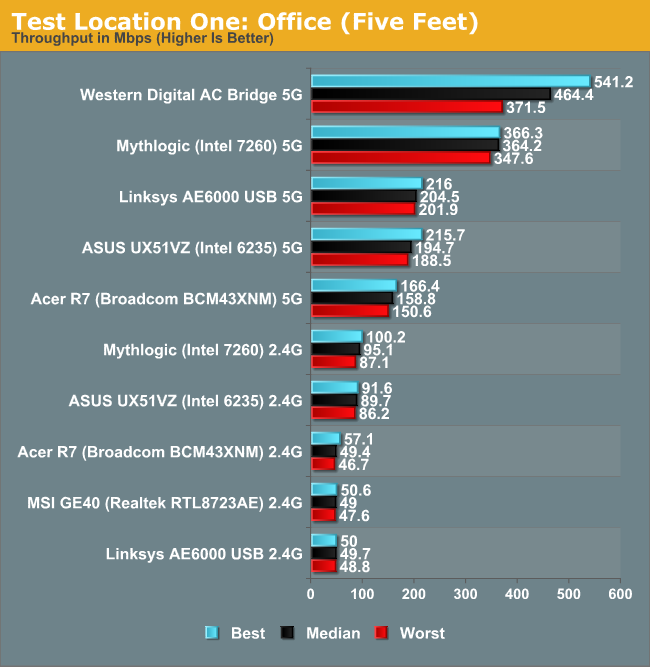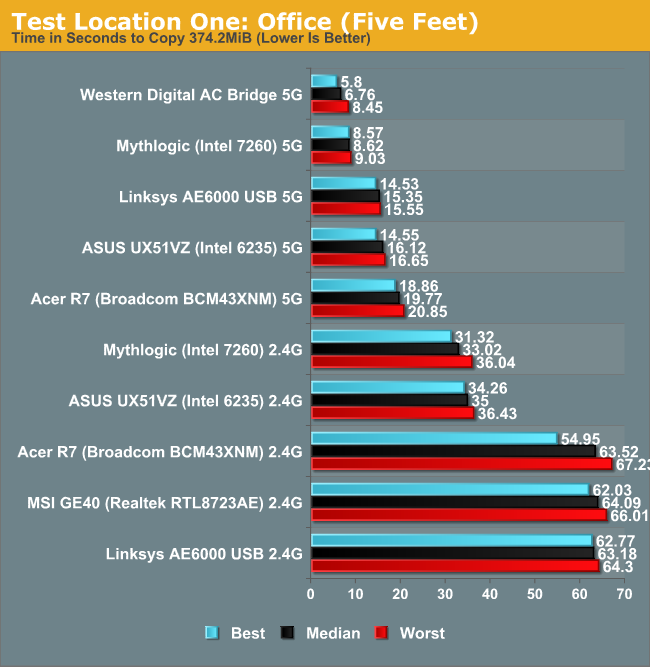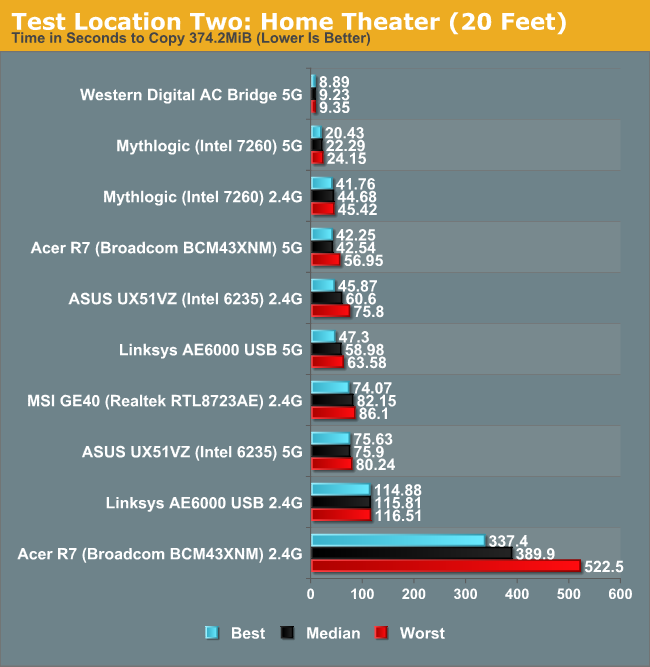The Joys of 802.11ac WiFi
by Jarred Walton on July 8, 2013 8:15 PM ESTA Quick Test of Real-World Wireless Performance
For testing, I grabbed a bunch of the hardware I had around and gathered one set of numbers: average throughput copying a single large file from my desktop with a wired Gigabit Ethernet connection to a laptop. I’m using Western Digital’s MyNet AC1300 router as the wireless router. The AC1300 is running firmware v1.03.09, and it's a product that has now been around for eight or so months. It supports up to 450Mbps (3x3:3 MIMO) on 802.11n connections and up to 1300Mbps on 5GHz 11ac connections. (Unfortunately, I didn't ever seem to connect with more than two 11ac streams with my current hardware, including Western Digital's AC Bridge.) We’re still not at Gigabit Ethernet speeds in most cases, but with nearly triple the throughput of the fastest 11n wireless it’s definitely getting closer.
For the adapters, I tested both single- and dual-band offerings. On the 802.11ac side, I used an 11ac bridge (the Western Digital My Net AC Bridge), a USB 11ac adapter (Linksys AE6000), and a Clevo P157SM notebook from Mythlogic (Pollux 1613) equipped with Intel’s latest Wireless-AC 7260 adapter. I should take a minute to note that one of the great things about going with a boutique laptop vendor like Mythlogic is the ability to customize not just the storage and CPU, but the WiFi adapter as well. Then I tossed in three other laptops, two of which I’m working on reviewing along with a previously reviewed laptop. The ASUS UX51VZ uses Intel’s common Wireless-N 6235 adapter (dual-band 2x2:2 MIMO with Bluetooth 4.0), Acer’s Aspire R7-571-6468 “oversized hybrid” uses a Broadcom BCM43XNM chipset (based on the hardware ID, it appears to be the BCM943228HM4L, or at least something similar—it’s also dual-band 2x2:2 MIMO with Bluetooth 4.0 support), and the MSI GE40 is the lone 2.4GHz single-band 150Mbps offering sporting a Realtek RTL8723AE chipset. All of the adapters were tested in both 2.4GHz and 5GHz modes (where applicable).
And with that said, here are the results from two test locations. Location one is with the target device in the same room as the router (my office), about five feet away. The second location is downstairs at the home theater area (my “second office”), about 20 feet away with one wall and one floor in between. The results show minimum, median, and maximum throughput of five test runs, with the caveat that I made sure there were no outliers—sometimes Windows or WiFi will have a really slow run or two.


Not surprisingly, the AC Bridge posts the best performance of all the solutions. With three spatial streams, I was hoping to get a lot closer to 800-900Mbps of throughput, but most of the time it appears to have run at closer to two streams. Performance isn't all that different from the Mythlogic laptop with Intel’s 7260 AC adapter at the short range location, but it’s over twice the speed at the second test location. What’s even worse is how poorly many of the solutions end up performing at the second test location.
I’m not surprised to see the Mythlogic notebook post excellent throughput over 5GHz 802.11ac, but it ends up being the third fastest solution even when falling back to 2.4GHz 802.11n at the second location! I could live with throughput of 50+ Mbps throughout my home, but pulling over 300Mbps from the downstairs HTPC to my other networked PCs over wireless is simply awesome…as long as the wireless signal doesn’t get dropped.
I haven’t actually had that happen with the Western Digital AC1300 (yet), but over the past seven or so years of testing notebooks and laptops for AnandTech, dropped wireless connections are a far too common occurrence in my experience. I’ve been through about ten wireless routers during that time, and even the best were never quite as stable/dependable as wired Ethernet. Some might go a couple weeks or even a month without needing a reboot (e.g. the Amped Wireless), while others might have WiFi "crash" every couple of days.
Throw in the lackluster WiFi adapters you find in most laptops (represented here by the Realtek RTL8723AE) and you can hopefully understand why having Gigabit Ethernet in notebooks still matters to a lot of people. I've got a second set of graphs that shows the same data as above, only in seconds required rather than Mbps:


Our current mobile test suite at present weighs in at a hefty 121GiB; over Gigabit Ethernet it takes about 20 minutes to copy everything over. Now imagine a laptop like the MSI GE40, except without the Ethernet port, and I’d be looking at nearly six hours just to copy the testing files over WiFi. (Thank goodness for USB 3.0 external SSD adapters!) But perhaps you never bother with copying large amounts of files over your local network, so slower WiFi speeds aren’t such an issue, right? My Comcast Internet now tops out with downstream speeds of up to 40Mbps and upstream rates of 12Mbps; when I’m not in my office, that means some of the adapters/laptops out there are likely going to bottleneck my Internet speed. It’s not the end of the world when you can only get 25Mbps, but there are certainly times when you’ll notice the difference—particularly if you have multiple PCs accessing the net concurrently.
One final item to discuss is that the adapters aren’t the whole story. You can see in the charts above that just because something supports two spatial streams on WiFi doesn’t inherently mean better performance than single stream adapters. The tiny USB WiFi adapter only manages average performance on a 5GHz connection from a couple rooms away from the router, and on a 2.4GHz connection it ends up being the slowest option outside of the Acer R7 2.4GHz result. Better antennas matter, and in the case of the Acer R7, the tuning of the antenna is likely another major factor.
The R7 actually fails to detect my 2.4GHz network from 50 feet away, yet it still manages to connect to the 5GHz network, and the R7 isn’t alone in such funky behavior. I’ve had laptops where the WiFi adapter powers off when the system has been running more than about 48 hours straight (even if the WiFi wasn’t doing anything), and the only way to get it back is to turn the adapter off and then turn it back on. And if laptops can sometimes have flaky WiFi implementations, many of the tablets out there are worse—range on two of my Android tablets is probably 50 feet at best before I have problems, so even my driveway is “too far” to get WiFi coverage.










139 Comments
View All Comments
JarredWalton - Wednesday, July 10, 2013 - link
One should be on the way (or I think it might be the newer model).ddriver - Wednesday, July 10, 2013 - link
No latency test? Really?JarredWalton - Wednesday, July 10, 2013 - link
Did you read the part in the article where I said, "This is a shorter introductory piece, so don’t expect a full suite of benchmarks..." I guess not.This was not intended to be a full review, but just to show that AC can be quite useful, and that we're working on testing some AC routers (which is in part a way of sending out a fishing line for additional products -- I've got two more coming already). The full review will look at latency, consistency of connection, and Rx/Tx speeds under more than one workload and at more than one location. Stay tuned....
ddriver - Wednesday, July 10, 2013 - link
Well, it is not like pinging is very challenging or time consuming, but whatever. Hopefully the full review will also include multiplayer gaming as well as other less typical workloads and naturally CPU load.JarredWalton - Wednesday, July 10, 2013 - link
Gaming is basically out, as I don't have the necessary equipment to test every single combination with the various WiFi adapters. I could test one adapter on one system with multiple routers, but most laptops have a whitelist of supported WiFi cards in their firmware so swapping cards in/out of a system doesn't generally work (and even if it does work with some, I'm not ready to tear apart someone's notebook review unit to accomplish the necessary testing).Please keep in mind that "comprehensive" looks at a technology can end up scaling the amount of testing time rapidly. If you have four routers and six adapters, you're already looking at 24 combinations to test. Now add in two more test locations and you get 96 combinations! Just the one "simple" test conducted in this article at two locations required a full day of testing to complete. Adding latency, copying lots of smaller files, then do the copy to the server rather than from the server (testing transmit rather than receive), and add in two more test locations to get an idea of how things look at 50' and 75', and I'm easily looking at a week or two dedicated purely to testing WiFi.
Simply put: I have a lot of other stuff on my plate, and while WiFi is definitely interesting, at some point I need to draw the line on what's in and what's out and write about the experience. My plan for now is to start with one router and several adapters (plus the bridge). Review that, then if everything checks out I can do the same tests on another router and so on. And in the meantime, I have a couple laptop reviews to complete, plus some other items as well, and a summer vacation to take. It might be a while before I'm done with this. :-)
kenthaman - Wednesday, July 10, 2013 - link
You should add the Ubiquity UniFi UAP-AC to your wifi testbed. I'd really like to see how their numbers rate compared to the other devices you've tested.JarredWalton - Wednesday, July 10, 2013 - link
We should be getting the UniFi 3.0 for testing as well.fc528e - Wednesday, July 10, 2013 - link
Very nice comprehensive review of 11ac as it currently stands! I'm really glad you were able to compile these results from an array of devices. Sounds like a worthy upgrade (assuming good hardware on the receiving end is there).Laststop311 - Wednesday, July 10, 2013 - link
I'll never give up my wired gbit connection. It's much easier knowing when the net messes up that you know its not the connection to the comp. And when you reformat the intel ethernet nic's just kinda work wifi gotta find drivers. I can see changing to 10gbit wired when that penetrates the consumer space. Especially with ssd's really need the bandwidth. SSD's are basically bottlenecked by the 6 gbps sata III limitation (the top ssd's at least). So hopefully 10gbit ethernet will be standard when sata express is standard. Wired is lower latency as well. People can't hack into it with a laptop parked in front of your house and steal bandwidth and do illegal stuff, neighbors can't hack it and mooch free internet off you. And there is still a ton of value in houses coming pre ethernet wired with ports in every room. I know that will be a requirement usb 3.0 ports and 10gbit ethernet ports with the power jacks in the next house i buy.HisDivineOrder - Thursday, July 11, 2013 - link
It's sad. I haven't seen a router that compelled me since my DIR-655. Years and years now. It isn't even that good, requiring reboots every month or so. I don't trust the new firmwares they put out any more and perhaps the new wireless hotness would be nice, but the truth is I don't feel like throwing down another $50-200 for the new hotness and have it be same as the old hotness with a slightly faster speed.Gigabit is all I need. I've been vaguely tempted by the faster processors and greater memory in recent Asus routers, but this article shows when you get outside of the same room, wireless starts to show only very narrow differences.
And latency still sucks. For the same reason I don't use wireless keyboards and mice for my everyday system is the same reason I wouldn't use wireless networking on my everyday system.
That said, having wireless is better than not just for the option. Until tablets, smartphones, consoles, laptops, and everything else use the NEW wireless spec (and it becomes officially released instead of a beta), there's just no reason to buy in yet.
By the time they finally get around to putting out affordable Nexus-class devices with it integrated and iPad's with it and most laptops have it, we should have cheaper and better routers with it, too.